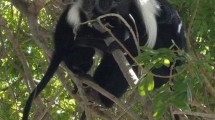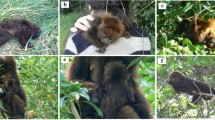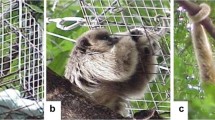Abstract
We observed a case of infant adoption in an unprovisioned group of wild black-fronted titi monkeys (Callicebus nigrifrons). During our long-term field study we noticed that an infant had moved from one of our study groups (“Desbotado”) to another (“Rio”). Observations of the adoptive group confirm that it was being cared for by the adult male, and initially the group’s adult female was nursing the infant alongside her biological infant. Interestingly, the native and adoptive groups have frequent inter-group interactions, but at no point have we observed the native group trying to retrieve its infant. As of April 2007 the infant has been living in its adoptive group for 19 months. These data document the first case of adoption in this genus; they suggest that infant recognition is poorly developed in this species and that under certain circumstances wild groups of C. nigrifrons can successfully rear twins. In our study population reproductive females give birth to one infant every year; the only case when this has not happened is with the group that adopted the infant, suggesting that adoption may generate a reproductive cost.
Similar content being viewed by others
Avoid common mistakes on your manuscript.
Introduction
Adoption can be considered to have occurred in primates when a lactating female associates for a prolonged period of time with a nutritionally dependent infant that is not her offspring (Maestripieri 2001). Spontaneous or naturalistic adoption normally occurs either when a female has recently lost her infant or when a female accepts another infant alongside her own offspring (i.e., a “twin”).
A number of experimental studies with primates in captivity show that female primates under certain circumstances (e.g., recent loss of own infant) will readily adopt an infant (Maestripieri 2001). Spontaneous adoption of infants in captive primates has also been observed (Fucillo et al. 1983). Cases of adoption by primates in the wild are extremely rare (Maestripieri 2001; Izar et al. 2006).
Most aspects of the natural history of the Atlantic forest titi monkeys are unknown and sometimes inferred from Amazonian members of their genus. These data suggest that titi monkeys as a genus are monogamous, live in small family groups (reproductive pair plus sub-adults, juveniles and infants) and are highly territorial (Valeggia 1998). However, there are no published studies to confirm this information in Atlantic forest species of titi monkeys. The few studies of Atlantic forest species (Callicebus personatus melanochir) of titi monkeys have focused on feeding behavior (Heiduck 1997, 2002). No scientific field studies have been published concerning the natural history or behavioral biology of our study species Callicebus nigrifrons.
In this study we document the first observed case of adoption and post-adoption survival in the genus Callicebus and suggest various hypotheses to explain this behavior.
Methods
Our subjects were five groups of C. nigrifrons that have been continuously studied using direct behavioral observations by us since January 2003. These animals are highly habituated to human observer presence and can be identified by natural marks. The five groups all live in the same small fragment (approximately 50 ha) in a large matrix of Atlantic forest in the Private Nature Reserve of Serra do Caraça, Minas Gerais, Brazil (20°05S; 43°29W).
All observations were conducted during the whole period of natural light (approximately from 07:00 to 18:00 h) during which we made focal animal observations of 15 min duration with instantaneous recording of behavior every 60 s.
Results
On 17 September 2005 we were observing a group called “Desbotado,” which during our observations in July and August of 2005 was comprised of an adult pair, a sub-adult male, juvenile male and an infant (sex unknown) that was born in July 2005. Upon encountering the group at around 08:00 hours in the field, we noticed that its infant had disappeared. We continued making observations of this group until approximately 13:30 hours when we lost sight of this group. In an area only a few hundred meters from where we lost sight of the group “Desbotado,” we encountered the group “Rio” at approximately 14:35 hours, which in July and August of 2005 was composed of an adult pair, a sub-adult male, a juvenile female and an unsexed infant (born in July 2005). Observations of the group with binoculars revealed that the adult male was now carrying two infants on his back. However, it was not possible to definitely confirm the identity of the two infants. During subsequent observations we observed the adult female nursing the two infants and the adult male providing transport and care.
Observations over the subsequent 18 months have shown that the native group and adoptive group of the infant have frequent encounters (Cäsar and Young unpublished data), but never has the native group tried to retrieve its infant. As of April 2007 the infant is still living in its adoptive group. In terms of interaction, the two infants were the nearest neighbor of each other for 70.58% of the time.
Our demographic data on these groups of C. nigrifrons show that all females give birth to one infant each year, normally during the month of July or early August. The reproductive female in the group that adopted the infant did not give birth in 2006 (10 months after the adoption).
Discussion
Due to our long-term collection of behavioral and demographic data on this population of titi monkeys, we are certain that this is a case of adoption as we had observed the two groups involved with only one infant in the birth season of 2005. In our population all births occur during the months of July or early August, and females have an inter-birth interval of 1 year, which has also been seen in C. moloch (Valeggia et al. 1998). Furthermore, we have not observed twinning in our population in 3 years of observations. How the infant was adopted by another group is unknown. It could have been “kidnapped,” but this explanation is unlikely as its adoptive group already had an infant of a similar age: most primate “kidnappings” occur when a female’s infant has recently died (Schino et al. 1993; Maestripieri 2001). In the field we have observed on several occasions infants falling to the forest floor and their group descending to rescue them. It could be on one such occasion that an infant remained lost and was later found by another group.
The adoption observed in this study appears to fall into the category of a “twin” adoption, that is, the adoption of an infant of a similar age and size to that of a living offspring (Maestripieri 2001). However, in the case of C. nigrifrons the adoption process is somewhat more complex since in this species the female only provides milk for the infant. All other parental care and social activities with the infant are performed primarily by the adult male in the group (Marcolino et al. 2006). Thus, in the case of adoption by C. nigrifrons there is an argument to include male primates in the definition of adoption (see “Introduction”).
The observed case of adoption suggests that mother–infant or father–infant recognition systems, if they exist, are poorly developed in C. nigrifrons. Given the territorial nature of this genus it may be that mother–infant recognition systems do not need to be highly developed as the likelihood of encountering a non-related infant should be low. Alternatively, it may be that neighboring groups have close genetic relatedness and, therefore, this case of adoption could be explained as an act of kin altruism (see Bukacinski et al. 2000).
The adopted infant in our study as of April 2007 is 19 months old and already a highly independent juvenile living with its adoptive group. In terms of behavior we cannot differentiate the two infants or the treatment they receive from other group members. Interestingly in the common situation of a singleton infant most of the social play behavior occurs between the adult male and the infant (Marcolino et al. 2006), whereas in the ‘twin situation’ the social play occurred between the two infants.
There is one recorded case of twinning in the wild in the genus Callicebus, this being in the dusky titi monkey, Callicebus cupreus (Knogge and Heymann 1996); however, cases of twins in titi monkeys in captivity or in the wild normally end with the death of one infant soon after birth (Knogge and Heymann 1996; Valeggia et al. 1998). Therefore, our observation shows that under certain ecological conditions in the wild our species may be able to successfully rear twins. However, the rearing of two infants may have a reproductive cost in C. nigrifrons, which is the failure to reproduce in the next reproductive season. Lower reproductive success due to lactation stress has been reported in various mammal species (König et al. 1988; Clutton-Brock et al. 1989; Lee 1996).
References
Bukacinski D, Bukacinski M, Lubjuhn T (2000) Adoption of chicks and the level of relatedness common gull, Larus canus, colonies: DNA fingerprinting analyses. Anim Behav 59:289–299
Clutton-Brock TH, Albon SD, Guinness FE (1989) Fitness costs of gestation and lactation in wild mammals. Nature 337:260–262
Fuccillo R, Scucchi S, Troisi A, D’Amato FR (1983) Newborn adoption in a confined group of Japanese macaques. Am J Primatol 5:257–260
Heiduck S (1997) Food choice in masked titi monkeys (Callicebus personatus melanochir): selectivity or opportunism? Int J Primatol 18:487–500
Heiduck S (2002) The use of disturbed and undisturbed forest by masked titi monkeys Callicebus personatus melanochir is proportional to food availability. Oryx 36:133–139
Izar P, Verderane MP, Visalberghi E, Ottoni EB, Oliveira MG, Shirley J, Fragaszy D (2006) Cross-genus adoption of a marmoset (Callithrix jacchus) by wild capuchin monkeys (Cebus libidinosus): case report. Am J Primatol 68:692–700
Knogge C, Heymann EW (1996) Field observation of twinning in the dusky titi monkey, Callicebus cupreus. Folia Primatol 65:118–120
König B, Riester J, Mark H (1988) Maternal care in house mice (Mus musculus): II the energy cost of lactation as a function of litter size. J Zool 216:195–210
Lee PC (1996) The meanings of weaning: growth, lactation, and life history. Evol Anthropol 5:87–89
Maestripieri D (2001) Is there mother–infant bonding in primates? Dev Rev 21:93–120
Marcolino CP, Young RJ, Cäsar CD (2006) Avaliação comportamental de Callicebus nigrifrons em resposta à introdução de indivíduos para formação de novos grupos em cativeiro. In: Lobato W, Sabino CVS, de Abreu JF (eds) Destaques 2005 Iniciação Científica. Belo Horizonte: Editora PUCMINAS, pp 85–98
Schino G, Aureli F, D’Amato FR, D’Antoni M, Pandolfi N, Troisi A (1993) Infant kidnapping and co-mothering in Japanese macaques. Am J Primatol 30:257–262
Valeggia CR, Mendoza SP, Fernandez-Duque E, Mason WA, Lasley B (1998) Reproductive biology of female titi monkeys (Callicebus moloch). Am J Primatol 47:183–195
Acknowledgments
We are grateful to Padres Célio, Wilson and Sebastian for allowing us to work in their reserve and to Consuelo and Aline for their support. This study was generously funded by FAPEMIG and PUC Minas. Furthermore, we would like to thank all past members of this long-term project: Guedes D., Ferreira, S. Q., Nahur A., Neves P.H., Sena M., Assunção M., Franco E. and Soares, G. We can confirm that all of the research reported in this article was conducted in compliance with all relevant Brazilian laws.
Author information
Authors and Affiliations
Corresponding author
About this article
Cite this article
Cäsar, C., Young, R.J. A case of adoption in a wild group of black-fronted titi monkeys (Callicebus nigrifrons). Primates 49, 146–148 (2008). https://doi.org/10.1007/s10329-007-0066-x
Received:
Accepted:
Published:
Issue Date:
DOI: https://doi.org/10.1007/s10329-007-0066-x




